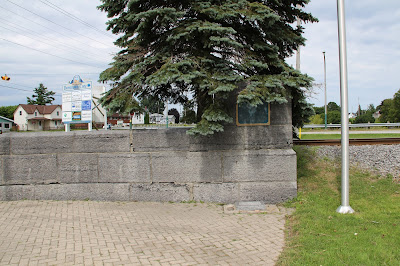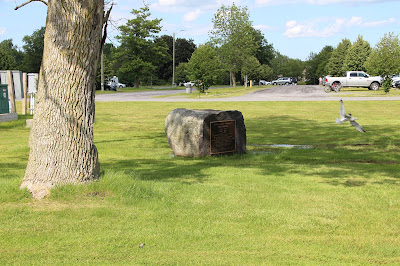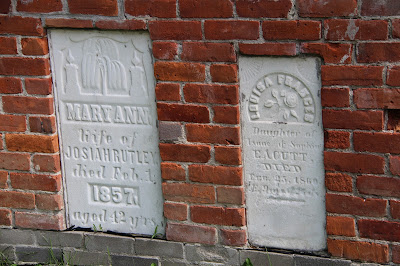The Founding of Cardinal Plaque, in Cardinal, Ontario, occupies a place mounted on the south end of the Cardinal War Memorial structure on the southwest corner of County Road 2 and Bridge Street.
THE FOUNDING OF CARDINAL
The grist-mill built at Point Cardinal by Hugh Munro about 1756 fostered the development here of a small settlement. A sawmill and store were later erected, and in 1837 a post-office, "Edwardsburgh," was established. In 1858, attracted by abundant water-power and the operation of the Galops shipping canal (1846) and the Grand Trunk Railway (1855), William T. Benson and Thomas Aspden founded the Canada Starch Works. Its prosperity stimulated the growth of Elgin, as Edwardsburgh was also known, and in 1864 the hamlet with 300 inhabitants, contained several other prominent businesses, notably the James McLatchie foundry. The community was incorporated as the Village of Cardinal, with a population of 800, by a by-law which became effective in 1880.
ERECTED BY THE ONTARIO HERITAGE FOUNDATION,
MINISTRY OF CULTURE AND RECREATION

Thursday, November 30, 2017
Monday, November 27, 2017
Cardinal Centennial Library Plaques
In Cardinal, Ontario, the public library and plaques associated with it occupy a location on the northeast corner of County Road 2 and Dishaw Street.
Thursday, November 23, 2017
War of 1812 Plaques
On Iroquois Island in Iroquois, Ontario in a park overlooking the Iroquois lock stands a memorial with four plaques detailing aspects of the War of 1812.
TOUSSAINT ISLAND AMBUSH
16 SEPTEMBER 1812
The 1st Regiment of Dundas Militia under Captain Michael Ault, supported by the Grenville Militia , counter-attacked American forces on Toussaint Island, thwarting enemy plans to ambush and capture Lieutenant Fitzgibbon's 49th Regiment of Foot suppy convoy. Loss of life was incurred by both opposing forces.
EMBUSCADE DE L'ÎLE TOUSSAINT
16 SEPTEMBRE 1812
Le 1er régiment de la milice de Dundas sous les ordres du Capitaine Michael Ault, appuyé par la milice de Grenville, a contre attaqué les forece américaines sur l'Île toussaint, déjouant les projets ennemis d'embrusquer et de prendre le convoi de 49ième régiments de Fantassins sous les ordres du Lieutenant Fitzgibbon. Il y a perte de vies parmi les deux forces opposées.
Donation by/de
Frank Ault
CAPTURING POINT IROQOIS
7 NOVEMBER 1813
U.S. General Wilkinson's invasion force met armed resistance by some 200 troops of teh 1st Regiment of Dundas Militia. 1200 troops of the 1st U.S. Rifle Regiment routed the militia and captured Point Iroqous. By delaying the enemy here and joining Lieutenant-Colonel Morrison's forces, the 1st Regiment of Dundas Militia contributed significantly to the successful Battle of Crysler's Farm.
PRISE DE LA POINTE DES IROQUOIS
7 NOVEMBRE 1813
La force envahissante du général américain Wilkinson a affronté la résistance armée de quelque 200 soldats du 1er régiment de la milice de Dundas. 1200 soldats du 1er régiment des fusiliers américains ont dérouté la milice et capturé la Pointe des Iroquois. En retardant ici l'ennemi et en rejoignant les forces du lieutenant-colonel Morrison, le 1er régiment de la milice de Dundas a contribué largement au succès du combat de la ferme Crysler.
Donation by/de
Friendly Brothers (Masonic)
Lodge No. 143 Iroquois
1ST REGIMENT OF DUNDAS MILITIA
1812-1814
Veterans of the American Revolutionary War from the King's Royal Regiment of New York and Jessop's Corps of Loyal Rangers made up the core of the 1st Regiment of Dundas Militia. In addition United Empire Loyalists and other immigrant and Aboriginal men between 16 and 60 were obligated to take up arms in defence of "The Front."
1ERE RÉGIMENT DE LA MILICE DE DUNDAS
1812-1814
Des vétérans de la guerre révolutionnaire américaine, du régiment Royal de New York, et du corps de la garde montée loyale de Jessop, constituaient le noyau du 1er régiment d la milice de Dundas. De plus, des loyalistes de l'empire uni ainsi que des hommes immigrants et indigènes âges de 16 à 60 ans furent contraints de prendre les armes à la défense du "Front."
Donation by/de
Cardinal (Masonic) Lodge No. 491
FORT NEEDLESS
1812-1814
The point Iroquois blockhouse witnessed shots fired on U.S. General Wilkinson's invasion forces. Captured and burned on the 7th of November 1813, the blockhouse was rebuilt in 1814. As hostilities had ended in this area, British troops referred to it as "Fort Needless."
LE FORT INUTILE
1812-1814
Le blockhaus de la Pointe des Iroquois fut témoin de coups de feu dirigés sur les forces envahissantes du général américain Wilkinson. Pris et incendié le 7 novembre 1813, le blockhaus fut reconstruit en 1814. Les hostilités ayant cessé dans ce secteur, les troupes anglaises lui ont attribué le nom de "Fort Inutile."
Donated by/de
Iroqois Matilda Lions Club
TOUSSAINT ISLAND AMBUSH
16 SEPTEMBER 1812
The 1st Regiment of Dundas Militia under Captain Michael Ault, supported by the Grenville Militia , counter-attacked American forces on Toussaint Island, thwarting enemy plans to ambush and capture Lieutenant Fitzgibbon's 49th Regiment of Foot suppy convoy. Loss of life was incurred by both opposing forces.
EMBUSCADE DE L'ÎLE TOUSSAINT
16 SEPTEMBRE 1812
Le 1er régiment de la milice de Dundas sous les ordres du Capitaine Michael Ault, appuyé par la milice de Grenville, a contre attaqué les forece américaines sur l'Île toussaint, déjouant les projets ennemis d'embrusquer et de prendre le convoi de 49ième régiments de Fantassins sous les ordres du Lieutenant Fitzgibbon. Il y a perte de vies parmi les deux forces opposées.
Donation by/de
Frank Ault
CAPTURING POINT IROQOIS
7 NOVEMBER 1813
U.S. General Wilkinson's invasion force met armed resistance by some 200 troops of teh 1st Regiment of Dundas Militia. 1200 troops of the 1st U.S. Rifle Regiment routed the militia and captured Point Iroqous. By delaying the enemy here and joining Lieutenant-Colonel Morrison's forces, the 1st Regiment of Dundas Militia contributed significantly to the successful Battle of Crysler's Farm.
PRISE DE LA POINTE DES IROQUOIS
7 NOVEMBRE 1813
La force envahissante du général américain Wilkinson a affronté la résistance armée de quelque 200 soldats du 1er régiment de la milice de Dundas. 1200 soldats du 1er régiment des fusiliers américains ont dérouté la milice et capturé la Pointe des Iroquois. En retardant ici l'ennemi et en rejoignant les forces du lieutenant-colonel Morrison, le 1er régiment de la milice de Dundas a contribué largement au succès du combat de la ferme Crysler.
Donation by/de
Friendly Brothers (Masonic)
Lodge No. 143 Iroquois
1ST REGIMENT OF DUNDAS MILITIA
1812-1814
Veterans of the American Revolutionary War from the King's Royal Regiment of New York and Jessop's Corps of Loyal Rangers made up the core of the 1st Regiment of Dundas Militia. In addition United Empire Loyalists and other immigrant and Aboriginal men between 16 and 60 were obligated to take up arms in defence of "The Front."
1ERE RÉGIMENT DE LA MILICE DE DUNDAS
1812-1814
Des vétérans de la guerre révolutionnaire américaine, du régiment Royal de New York, et du corps de la garde montée loyale de Jessop, constituaient le noyau du 1er régiment d la milice de Dundas. De plus, des loyalistes de l'empire uni ainsi que des hommes immigrants et indigènes âges de 16 à 60 ans furent contraints de prendre les armes à la défense du "Front."
Donation by/de
Cardinal (Masonic) Lodge No. 491
FORT NEEDLESS
1812-1814
The point Iroquois blockhouse witnessed shots fired on U.S. General Wilkinson's invasion forces. Captured and burned on the 7th of November 1813, the blockhouse was rebuilt in 1814. As hostilities had ended in this area, British troops referred to it as "Fort Needless."
LE FORT INUTILE
1812-1814
Le blockhaus de la Pointe des Iroquois fut témoin de coups de feu dirigés sur les forces envahissantes du général américain Wilkinson. Pris et incendié le 7 novembre 1813, le blockhaus fut reconstruit en 1814. Les hostilités ayant cessé dans ce secteur, les troupes anglaises lui ont attribué le nom de "Fort Inutile."
Donated by/de
Iroqois Matilda Lions Club
Monday, November 20, 2017
St. Lawrence Seaway Plaque
Situated in a park that overlooks the Iroquois lock at the end of Carman Road in Iroquois, Ontario, a plaque commemorates the fiftieth Anniversary of the St. Lawrence Seaway.
THE ST. LAWRENCE SEAWAY
The St. Lawrence Seaway was inaugurated by Her Majesty Queen Elizabeth II and the President of the United States of America, Dwight D. Eisenhower, on June 26, 1959. The Seaway has opened up the industrial Great Lakes Region of North America to the trading nations of the world, and it has provided an improved navigation for the transportation of Canadian goods to consuming countries.
This plaque is erected by the Canadian Canal Society in cooperation with the St. Lawrence Seaway Authority and the Ministry of Citizenship and Culture, Ontario to recognize the 25th Anniversary of this great waterway.
1984
LA VOIE MARITIME DU SAINT-LAURENT
C'est le 26 juillet 1959 que la reine Elizabeth II et le président des États-Unis d'Amérique, M. Dwight D. Eisenhower, ont inauguré la voie maritime du Saint-Laurent. Cette voie a overt la région industrielle des Grands Lacs aux nations commerçantes du monde, et elle a amélioré le transport maritime de merchandises canadiennes vers les pays importateurs.
Cette plaque a été érigée par la Société des canaux du Canada, en collaboration avec l'Administration de la voie maritime du Saint-Laurent et le ministère des Affaires civiques et culturelles de l'Ontario, a l'occasion du 25e anniversaire de l'inauguration de cette importante voie de navigation.
1984
THE ST. LAWRENCE SEAWAY
The St. Lawrence Seaway was inaugurated by Her Majesty Queen Elizabeth II and the President of the United States of America, Dwight D. Eisenhower, on June 26, 1959. The Seaway has opened up the industrial Great Lakes Region of North America to the trading nations of the world, and it has provided an improved navigation for the transportation of Canadian goods to consuming countries.
This plaque is erected by the Canadian Canal Society in cooperation with the St. Lawrence Seaway Authority and the Ministry of Citizenship and Culture, Ontario to recognize the 25th Anniversary of this great waterway.
1984
LA VOIE MARITIME DU SAINT-LAURENT
C'est le 26 juillet 1959 que la reine Elizabeth II et le président des États-Unis d'Amérique, M. Dwight D. Eisenhower, ont inauguré la voie maritime du Saint-Laurent. Cette voie a overt la région industrielle des Grands Lacs aux nations commerçantes du monde, et elle a amélioré le transport maritime de merchandises canadiennes vers les pays importateurs.
Cette plaque a été érigée par la Société des canaux du Canada, en collaboration avec l'Administration de la voie maritime du Saint-Laurent et le ministère des Affaires civiques et culturelles de l'Ontario, a l'occasion du 25e anniversaire de l'inauguration de cette importante voie de navigation.
1984
Thursday, November 16, 2017
Construction of the St. Lawrence Seaway Plaque
At the south end of Carman Road in Iroquois, Ontario there is a stretch of road with parking so that visitors can watch lake boats go through the Iroquois lock. A memorial site there has a plaque about the construction of the St. Lawrence Seaway.
THE CONSTRUCTION OF THE ST. LAWRENCE SEAWAY
Impressive for its immense scale, organizational complexity, and speedy completion, the construction of the St. Lawrence Seaway from 1954 to 1959 was an outstanding engineering achievement. This project, which included hydroelectric power generation and water-level control, transformed shipping on the St. Lawrence River above Montréal by allowing ocean-going vessels access to the Great Lakes. Acting in close cooperation, the Canadian and American governments coordinated the planning and construction needed to complete this remarkable undertaking on the world's longest inland waterway.
Historic Sites and Monuments Board of Canada
LA CONSTRUCTION DE LA VOIE MARITIME DU SAINT-LAURENT
La construction de la Voie maritime du Saint-Laurent, entre 1954 et 1959, constitue un haut fait d'ingénerie par son ampleur, sa complexité et son exécution rapide. De projet, qui comprend la production d'hydroélectricité et le contrôle du niveau des eaux, a transformé le transport sur le fleuve Saint-Laurent en permettant aux navires océaniques d'accéder aux Grands Lacs à partir de Montréal. La collaboration étroite des gouvernements canadien et américain a permis la planification et la réalisation de cette enterprise d'envergure sur la plus longue voie de navigation intérieur au monde.
Commission des lieux et monuments historiques du Canada
THE CONSTRUCTION OF THE ST. LAWRENCE SEAWAY
Impressive for its immense scale, organizational complexity, and speedy completion, the construction of the St. Lawrence Seaway from 1954 to 1959 was an outstanding engineering achievement. This project, which included hydroelectric power generation and water-level control, transformed shipping on the St. Lawrence River above Montréal by allowing ocean-going vessels access to the Great Lakes. Acting in close cooperation, the Canadian and American governments coordinated the planning and construction needed to complete this remarkable undertaking on the world's longest inland waterway.
Historic Sites and Monuments Board of Canada
LA CONSTRUCTION DE LA VOIE MARITIME DU SAINT-LAURENT
La construction de la Voie maritime du Saint-Laurent, entre 1954 et 1959, constitue un haut fait d'ingénerie par son ampleur, sa complexité et son exécution rapide. De projet, qui comprend la production d'hydroélectricité et le contrôle du niveau des eaux, a transformé le transport sur le fleuve Saint-Laurent en permettant aux navires océaniques d'accéder aux Grands Lacs à partir de Montréal. La collaboration étroite des gouvernements canadien et américain a permis la planification et la réalisation de cette enterprise d'envergure sur la plus longue voie de navigation intérieur au monde.
Commission des lieux et monuments historiques du Canada
Monday, November 13, 2017
Tecumseh Plaque
A plaque commemorating Tecumseh, mounted on a large rock, occupies a location just west of the parking lot for Upper Canada Village, south of County Road 2.
Thursday, November 09, 2017
Upper Canada Pioneer Memorial
The Upper Canada Pioneer Memorial occupies a place just southwest of Upper Canada Village on the south side of County Road 2, east of Morrisburg, Ontario.
During the preliminary work on the St. Lawrence Seaway project, which, in 1959, culminated in the flooding that required many communities that had to be moved, tombstones from those communities' cemeteries were removed and placed on the walls of the Pioneer Memorial. The memorial has a central square with three rectangular extensions. The tombtones have been mounted on the inner walls organized by community and the specific cemeteries they came from. Though the memorial has a simplicity to its layout the order of the photographs here may not convey any sense as to where they are located within the memorial.
This garden is erected to commemorate the pioneer founders of Ontario who settled the upper St. Lawrence Valley.
Selected gravestones from cemeterieis in the eight communities submerged in 1958 beneat the St. Lawrence are set in walls of brick and stone from vanished pioneer buildings. Of th names not found upon these walls their best memorial is the country they lived to build.
Oh God of Bethel by whose hand they people still are fed who, through this weary pilgrimage hast all our fathers led.
Our vows, our prayers, we now present before they throne of grance God of our fathers be the God of their succeeding race.
During the preliminary work on the St. Lawrence Seaway project, which, in 1959, culminated in the flooding that required many communities that had to be moved, tombstones from those communities' cemeteries were removed and placed on the walls of the Pioneer Memorial. The memorial has a central square with three rectangular extensions. The tombtones have been mounted on the inner walls organized by community and the specific cemeteries they came from. Though the memorial has a simplicity to its layout the order of the photographs here may not convey any sense as to where they are located within the memorial.
 |
| EAST WILLIAMSBURG |
 |
| WOODLANDS |
 |
| MOULINETTE |
 |
| MILLE ROCHES |
 |
| AULTSVILLE |
 |
| FARRAN POINT |
 |
| WALES |
 |
| DICKINSON'S LANDING |
This garden is erected to commemorate the pioneer founders of Ontario who settled the upper St. Lawrence Valley.
Selected gravestones from cemeterieis in the eight communities submerged in 1958 beneat the St. Lawrence are set in walls of brick and stone from vanished pioneer buildings. Of th names not found upon these walls their best memorial is the country they lived to build.
Oh God of Bethel by whose hand they people still are fed who, through this weary pilgrimage hast all our fathers led.
Our vows, our prayers, we now present before they throne of grance God of our fathers be the God of their succeeding race.
Subscribe to:
Comments (Atom)

























































































